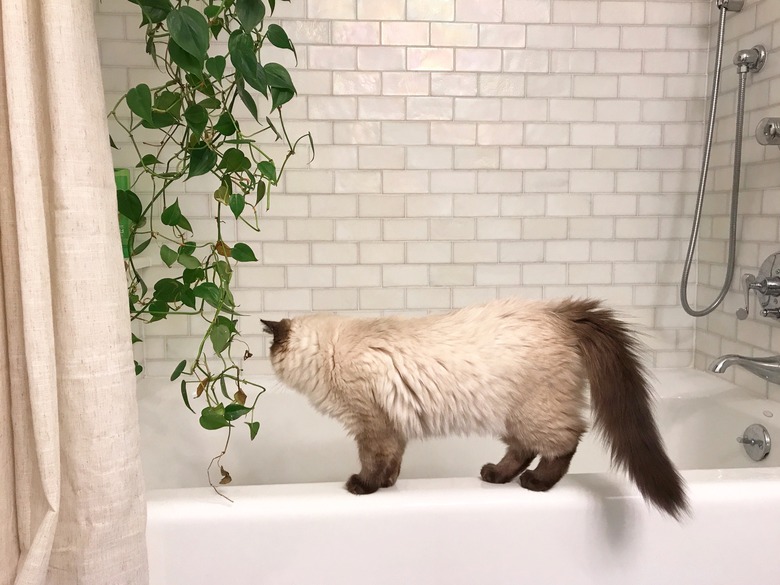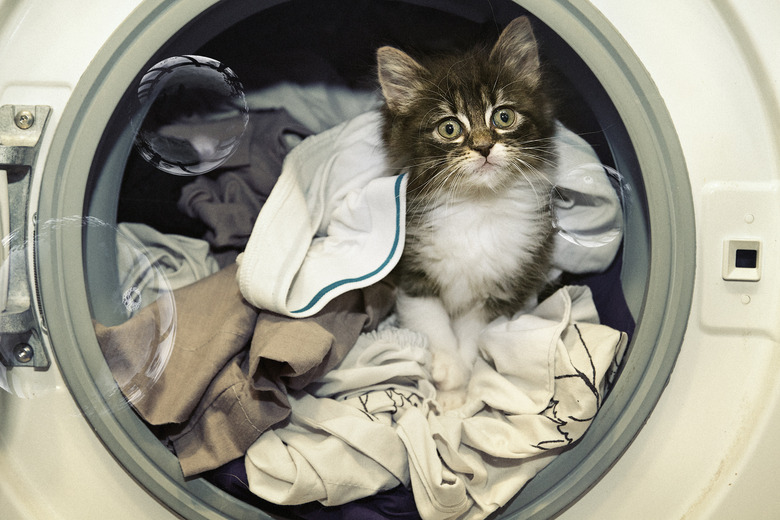Catproofing Your House: A Room-By-Room Checklist
We may receive a commission on purchases made from links.
Are you adding a new cat to your family? Bringing home a new pet for the first time is exciting, but a curious kitten needs to be protected at every turn in their new environment — and what many new cat owners may not realize is that there are several dangerous household items that can hurt your feisty feline. Catproofing your house with a room-by-room checklist helps you address those hazards so you can bring your new cat home to a safe environment and enjoy their whimsical personality for years to come.
Catproofing Your Cat's Eating, Sleeping and Bathroom Areas
Catproofing Your Cat's Eating, Sleeping and Bathroom Areas
Cats do enjoy their privacy, and it makes sense that your new cat will need areas for eating, sleeping and using the litter box. Use these catproofing tips for your cat's area:
- Keep pesticides and pest traps away from your cat's area or anywhere that your cat can access. They can cause digestive or neurological damage.
- Make a cat feeding station to elevate cat food and water bowls for easier use. The station keeps the bowls from sliding and spilling.
- Place a cat bed on the floor away from vents, electrical cords, air fresheners and other potential hazards.
- Put the cat litter box in a quiet, private area well away from your cat's food.
- Inspect cat toys regularly. Cats often like to play in cardboard boxes, so be sure to check the box for staples or other sharp objects and anything that spilled on the box, such as cleaner, that could be harmful.
- Keep a cat carrier handy for evacuating with her safely or for carrying her to the vet. Even with a microchip, your cat is at risk if he is running free outdoors.
Catproofing Your Living Room
Catproofing Your Living Room
Whether she's chasing after a laser pointer or bathing in the sunlight on your couch, your new cat will likely be cozying up in the living room at some point during the day (perhaps even staying an arm's length away so you can't pet her). Consider these tips to catproof your living room:
- Use a TV wall mount or TV straps to secure the unit. If your cat jumps up on a cabinet or a mantle and leans against an unsecured TV, it could tip.
- Secure cords to prevent your cat from chewing on them or toppling items. Cats will bat at anything that looks like it could be a toy, so use cable tie management straps to hold cords together and keep them tucked behind furniture.
- Install cordless blinds or tie up the cords to keep them away from your cats (and dogs and kids for that matter). They might become trapped in the cords if they mistake it for a string toy.
- Secure large furniture pieces, such as bookshelves and TV cabinets. If anything is wobbly or unstable, a cat jumping onto it or launching off it might cause it to tip.
- Rearrange decorative items that tip easily. Cats often enjoy batting at items, which can end with your favorite breakables falling and them getting injured.
- Consider eliminating candles since the flames can catch your cat's fur on fire if they happen to hop on the countertop at the right time. Replace them with battery-operated candles to get the same look.
- Check your houseplants to make sure they're not toxic to cats. Some toxic plants include lilies (Lilium sp.), English ivy (Hedera helix) and sago palm (Cycas revoluta), but there are many other species of toxic plants, so check each one accordingly. Swap them for cat-friendly houseplants, such as zebra plants (Haworthia fasciata) or money trees (Pachira aquatica).
- Install a scratching post or cat tree in your living room to discourage your cat from scratching your living room furniture.
- Use furniture protectors if your cat scratches furniture. You can get vinyl furniture-protecting sheets that cover upholstery. Declawing cats is not recommended by the American Society for the Prevention of Cruelty to Animals and many other organizations since it amputates part of the bone, so alternative methods to protect your belongings are best.
Catproofing Your Kitchen
Catproofing Your Kitchen
Food, sharp objects and cleaners are common kitchen hazards for cats. Make your cat's new surroundings safer with these tips:
- Put food away when you're done, especially food that can make your cat sick. Foods that are toxic for cats include onions, garlic, anything with xylitol, anything with alcohol and chocolate. Make sure all family members know the dangers of certain foods so they don't accidentally give them a taste.
- Lock up toxic cleaning chemicals. Pine-based cleaners or anything with phenol can cause liver damage, but other cleaners are also known to be dangerous for cats.
- Better yet, swap out your harsh cleaners for nontoxic or homemade cleaners, such as DIY pet-safe floor cleaners or all-purpose cleaners. If your cat walks across freshly cleaned surfaces, the residue from toxic cleaners can get on her paws and fur. She can ingest the chemicals if she licks herself afterward.
- Remove long tablecloths. Your new cat will be tempted to pull the tablecloth and everything on it off the table.
- Use a trash can with a securely closing lid or enclose it in a pantry. Cats might grab old food from the trash that makes them sick, and bones can cause internal damage or blockages.
- Put away knives and sharp utensils to avoid cuts on your cat's paws.
Catproofing Your Bathroom
Catproofing Your Bathroom
Although it might be her favorite room for shredding toilet paper, bathrooms have many potential hazards that can make your cat sick or cause injury. Make your bathroom safer for your new pet with these actions:
- Keep the toilet lid closed. A small cat could fall into the toilet and drown. Chemicals to clean or freshen your toilet can be toxic if your cat drinks the water.
- Secure medications. If you drop a pill, search until you find it so your cat doesn't ingest it.
- Lock up drain cleaners, toilet bowl cleaners and other bathroom cleaners. They often have toxic ingredients.
- Put razors in a secured location. The sharp blades will cut your cat if the razor becomes a toy.
Catproofing Your Bedrooms
Catproofing Your Bedrooms
Your bedroom might seem cozy and safe, but it has some petproofing concerns you should address. Take these precautions:
- Secure any small objects in bedrooms to prevent your new cat from swallowing them. Examples include rubber bands, hair ties, button batteries, sewing supplies and small toys.
- Hide cords for lamps, TVs and other electronics.
- Move loose items off your nightstand. Your cat might play with them and knock them off or swallow small items.
- Avoid using mothballs, which are toxic to cats.
Catproofing Your Laundry Room
Catproofing Your Laundry Room
It might be small, but your laundry room has serious dangers for curious cats. To make your laundry room safe for your new addition, consider these tips:
- Always keep the washer and dryer doors closed since some cats like to climb inside and nap. Running the machines with a cat inside can cause contusions, heatstroke and other serious or fatal injuries.
- Check the washer and dryer carefully before using them to make sure your cat isn't inside.
- Secure all laundry products, including detergent, fabric softener and dryer sheets, as they can be toxic.
- Close the laundry room door when it's not in use to keep your cat out.
Catproofing Your Garage or Shed
Catproofing Your Garage or Shed
It's best to keep your cat out of the garage or shed since they're full of potential dangers. Catproofing those areas makes them safer in case your feline sneaks into them. Use these tips:
- Secure all chemicals, especially products containing ethylene glycol, which includes anti-freeze and pool cleaning products. It only takes a small amount to cause kidney damage, and cats often die from ingesting it. Anti-freeze has a sweet smell and taste, which can tempt your cat to try it.
- Keep fuels, paints, fertilizers, pesticides, herbicides, cleaning supplies and all other chemicals secured.
- Avoid putting out rodent bait (poison), which can kill cats.
- Secure tools, such as rakes and shovels, with a tool storage rack to keep them from tipping over if your cat rubs against them.
- Do regular garage door maintenance to check the safety features. Block the sensor and push the garage door opener button to ensure the door doesn't close. Place a slim board on the ground in the way of the garage door but under the sensors. Close the garage door to ensure it automatically reverses as soon as it hits the board.


